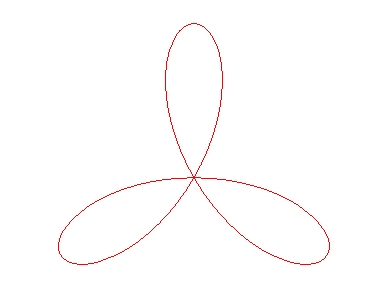REGULAR TRIFOLIUM

| next curve | previous curve | 2D curves | 3D curves | surfaces | fractals | polyhedra |
REGULAR TRIFOLIUM

| Curve studied by Longchamps in 1885, Brocard and d'Ocagne
in 1887.
From the Latin trifolium "trefoil". |
 |
Polar equation: Cartesian equation: Rational quartic. Length: Area: |
The regular trifolium is the rose with three petals.
It can be obtained as the trajectory of the second intersection
point between a line and a circle turning around one of their points, either
in the same direction and the circle four times as fast as the line, either
in opposite directions and the circle turning twice as fast as the line.
It can also be obtained as the trajectory of the second
intersection point between two identical circles turning around one of
their points, in opposite direction, one of them turning twice as fast
as the other.
 |
 |
 |
Therefore, it is a hypotrochoid
(base circle with radius ,
rolling circle with radius
,
distance from the point to the rolling circle =
),


It thus is also the envelope of a circle the diameter
of which joins the centre of a deltoid to a point on this deltoid.
| The regular trifolium can also by obtained by projections from a cylindric sine wave with 3 arches, through a 3D basin. |  |
See here how to "thicken" a trifolium to a get triple torus.
See the trifolium on the Roman
surface.
| next curve | previous curve | 2D curves | 3D curves | surfaces | fractals | polyhedra |
© Robert FERRÉOL 2017